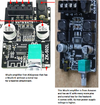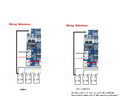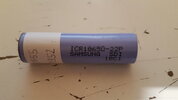I have to think whether its worth doing. Those buttons are mighty nice, perfect for what i need (since they are of nice square shape and they cover the hole with "wings"). But spraying wd40 into each one sounds not so much fun. And oil + conductivity somehow dont mix to me. But i have to try it.
The funniest thing. I have 3 speakers of same dimension, same everything except different amplifier. And i test them by playing audio from tablet 24/7 in my workshop. Suddenly i find out that on 1 speaker, the tweeter is hissing in certain tv shows when there is silent and then speech and then silence. I thought alright, tweeter is bust or amp is bust. Then the same happens on a second speaker and on a third one. Smart as i am, i put all 3 speakers apart, make a mess, only to find out that whatever is wrong, is with my tablet. In tablets defence - i repaired it, brought it back from bricked status. But yeah, using that tv over internet program, its hissing. Pretty sure it hisses from internal speaker of the tablet also, but its less heard due to its speaker being small and weak.
Anyway in the end i wasted like 1 hour to put all 3 speakers back together, seal them, glue them, clean them. And im happy to report that on all 3 speakers i get a nice sound when playing from either of my mobile phones (tested that tv over internet program, youtube, music, etc.).
Since all 3 speakers are of completely identical build except amplifiers, i could do some simple tests on them. Well actualy just 1 test: figure out which one is the loudest. Its basicaly 2x50W noname (my favourite of the 3), 2x50W TPA3116 and 2x30W TPA3116. The reason 2x50W noname (or "domestic chip" as its makers call it

) is the favourite to me is ... the TPA3116 ones .. when i turn on the speaker at max volume ... but play no music and have no bluetooth connection, u can hear a hiss. When i connect bluetooth hiss is less heard but still it is heard. Once i play music everything seems to be ok. Now this happened on 2 types of amps with TPA3116 so far. Its not a big bother to me but some people might look at it and say they dont like their speaker hissing. Well, the no name 2x50W doesn't have any hissing.
This is the no name amp i am talking about. I wish you would test it
audioguru and let me know what u think about it. Its super cheap:
Smarter Shopping, Better Living! Aliexpress.com

www.aliexpress.com





